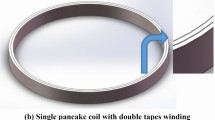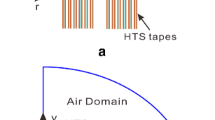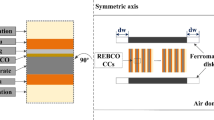Abstract
Second-generation (2G) high-temperature superconducting (HTS) tapes are now capable of carrying very high transport current and promising for a wide range of applications. The critical current of HTS coils is important for applications, such as superconducting electric machines, superconducting magnetic energy storage, and superconducting magnets. Therefore, precisely and quickly calculating critical current of HTS coils is very important for designing HTS devices. This paper provides a fast algorithm for evaluating critical current of HTS pancake coil. The fast algorithm is realized through a stationary model, which is based on finite element method (FEM) software. The stationary model means that the model is solved by stationary study instead of time-dependent study. To validate this method, a pancake HTS coil was wound and its critical current was measured. Meanwhile, an axial symmetric stationary model was built according to the geometry of the measured HTS coil. By comparing measured and calculated results, the effectiveness of the stationary model was demonstrated. Moreover, the stationary model is compared with H formulation model. The calculated results by the two models are nearly the same. However, by using stationary calculation, the stationary model can remarkably speed up the computational process. Due to the advantage of calculating speed, the stationary model can be used to characterize and design large-scale HTS applications.









Similar content being viewed by others
References
Kalsi, S.S.: Applications of high temperature superconductors to electric power equipment. Piscataway, IEEE Press (2011)
Xiao, L.Y., Wang, Z.K., Dai, S.T., Zhang, J.Y., Zhang, D., Gao, Z.Y., Song, N.H., Zhang, F.Y., Xu, X., Lin, L.Z.: Fabrication and tests of a 1 MJ HTS magnet for SMES. IEEE Trans. Appl. Supercond. 18, 770–773 (2008)
Yang, Y. et al.: Design and development of a cryogen-free superconducting prototype generator with YBCO field windings. IEEE Trans. Appl. Supercond. 26, 4 (2016)
Konishi, T., Nakamura, T., Nishimura, T., Amemiya, N.: Analytic evaluation of HTS induction motor for electric rolling stock. IEEE Trans. Appl. Supercond. 21(3), 1123–1126 (2011)
Campbell, A.M.: A direct method for obtaining the critical state in two and three dimensions. Supercond. Sci. Technol. 22, 034005 (2009)
Amemiya, N., Murasawa, S., Banno, N., Miyamoto, K.: Numerical modelings of superconducting wires for loss calculations. Phys. C 310, 16–29 (1998)
Hong, Z., Campbell, A.M., Coombs, T.A.: Numerical solution of critical state in superconductivity by finite element software. Supercond. Sci. Technol. 19(12), 1246–1252 (2006)
Zhang, M.: Study of second generation high-temperature superconducting coils: determination of critical current. J. Appl. Phys. 111(8), 083902–1–083902-8 (2012)
Hu, D. et al.: DC Characterization and 3D modelling of a triangular epoxy-impregnated high temperature superconducting coil. Supercond. Sci. Technol. 28, 6 (2015)
Zhang, H., Zhang, M., Yuan, W.: An efficient 3D finite element method model based on the T–A formulation for superconducting coated conductors. Supercond. Sci. Technol. 30(2), 024005 (2016)
Grilli, F. et al.: Self-consistent modeling of the IC of HTS devices: how accurate do models really need to b. IEEE Trans. Appl. Supercond. 24, 6 (2014)
Acknowledgments
This work was sponsored by the National Natural Science Foundation of China, “Numerical and experimental study of quench characteristics of superconducting coils for HTS wind generators,” Project No. 51641704. The authors would like to thank the Key Laboratory of Control of Power Transmission and Conversion (Ministry of Education), the Shanghai Engineering Center for Superconducting Materials and System, and the State Energy Smart Grid R&D Center (Shanghai) for the support on assistance in experimental affairs.
Author information
Authors and Affiliations
Corresponding author
Rights and permissions
About this article
Cite this article
Zhao, A., Huang, Z., Zhu, B. et al. Fast Algorithm for Evaluating Critical Current of High-Temperature Superconducting Pancake Coil. J Supercond Nov Magn 31, 307–312 (2018). https://doi.org/10.1007/s10948-017-4194-2
Received:
Accepted:
Published:
Issue Date:
DOI: https://doi.org/10.1007/s10948-017-4194-2




